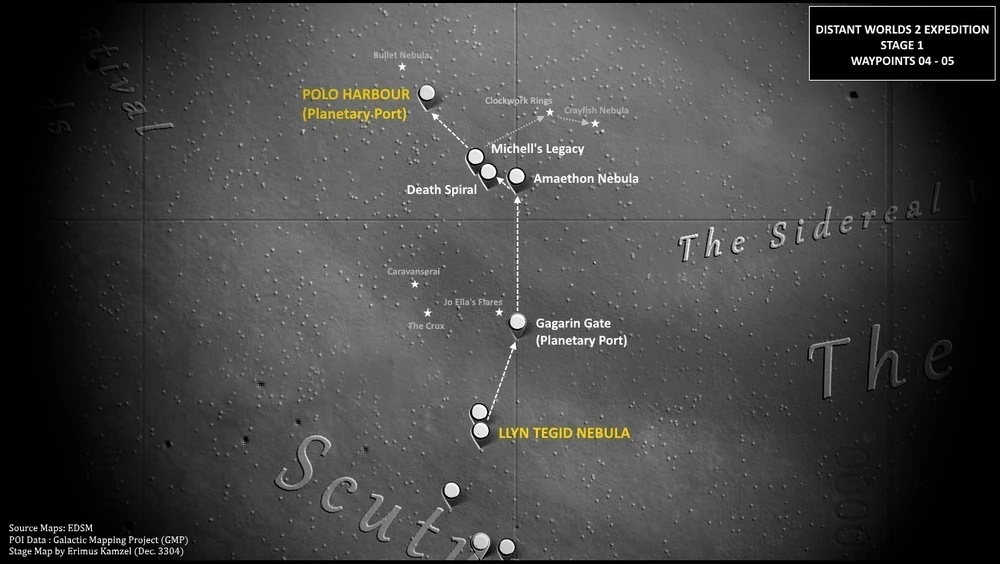
Byaa Ain XK-R c7-65 (2,388.78LY)
Crayfish Nebula
A small nebula that glows reds, this nebula sits over 1100 LY above the galactic plane and over 16,000LY from Sol.
Byaa Ain QA-J c11-144 (534.45LY)
Clockwork Rings
Twin ringed planets with high metal content orbit each other less than 1 lightsecond away. Each planet’s rings are perpendicular to other other’s, allowing for fascinating views. While both planets are landable, the 1.5 gravity planet is preferable over the other because of its higher 2.3 gravity.
Boewnst AA-A h33 (1,877.27LY)
Michell’s Legacy
A system containing 6 black holes. One of the highest concentrations of system-specific black holes currently discovered, it is named in honour of John Michell who first postulated the existence of black holes back in the 18th century.
Blaa Phoe NC-D d12-230 (618.17LY)
Death Spiral
This system contains a Class V gas giant that orbits its white dwarf primary in only 15 minutes, and passes through the jet of the White Dwarf! Its orbital distance from the WD is 0.4 ls, so close that it cannot actually be reached using supercruise (the WD drops the ship out of SC about 2 ls out). There is also a nearby M V companion star a few ls away. As an aside, there is an unusually high number of Carbon Star systems around this location too.
The planet is so close to the WD that (a) it is within the WD’s Roche Limit and should have been torn apart to form a ring system and (b) orbits faster than the WD’s rotation period (which itself is only 16 minutes) and therefore is spiralling in to the WD anyway due to tidal forces. The system is also 7.8 billion years old – how the gas giant continues to survive, how it got into its current orbit around the WD, and how the WD and its planet both got so close to the M V star after the end of the WD’s former red giant phase are all deep mysteries!
Floalt GO-G d11-9 (831.55LY)
Body: 4 E
Amaethon Nebula and Polonium Fields
This nebula is situated approximately 1,700ly away from the Polo Harbour spaceport in the Venetian Nebula, and posesses a sizable number of large stars in the blue-white range. Fungal bark mounds have been found to exist on bodies around stars in the nebula (at Floalt KU-E D12-218) giving reason for Commanders to explore the nebula further. Many systems are still untouched by human exploration, and a further survey could lead to greater finds in this untouched area of space.
The nebula displays various hues of blue and orange, and looks quite stunning.
Inside the Amaethon Nebula nebula lies Polonium Fields, a small moon in an otherwise unassuming system. At 2.1% Polonium, this moon contains the highest known concentration of Polonium in the galaxy. At just over 500km, this small moon has only 0.03 gravity, making it a challenge to navigate the long, wide canyons that cross the moon. However, the open plains allow the experienced explorers to quickly fill their stock of Polonium.
Gru Hypue KS-T d3-31 (1,977.33LY)
Body: 4
Gagarin Gate
One of the Colonia Connection Highway outposts, constructed in October 3302. Located inside the Vostok-1 nebula, this port is named after old Earth astronaut Yuri Gagarin.
This red and pinkish nebula, situated in the Heart of the Sagittarri Conflux, sits around 1,000 LYs below the galactic plane.
The nebula is quite dense in places but its lower reaches become extremely diffuse.
The Vostok Nebula was named in honour of the first spaceflight of the Vostok programme and the first manned spaceflight in history. The Vostok 3KA space capsule was launched on April 12, 1961 from Baikonur Cosmodrome, Soviet Union, Earth, with Soviet cosmonaut Yuri Gagarin, making him the first human to cross into outer space.
Waypoint 4: Clooku EW-Y c3-197 (1,767.19LY)
Original meetup date: 8/2/3305
Body: 5 G A
The Llyn Tegid Nebula
This body was chosen for the meet up point of Waypoint 4 of Distant Worlds 2. The original coordinates of the meetup were 56.305, 111.854 and named Shepard Shallows.

